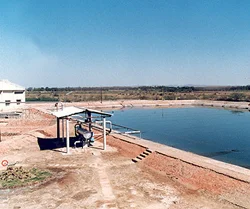Solar Pond
Solar energy is an abundant and renewable energy source. The annual solar energy incident at the ground in India is about 20,000 times the current electrical energy consumption. The use of solar energy in India has been very limited. This is because solar energy is a dilute energy source (average daily solar energy incident in India is 5 kWh/m 2 day) and hence energy must be collected over large areas resulting in high initial capital investment; it is also an intermittent energy source.
A solar pond is a pool of saltwater which acts as a large-scale solar thermal energy collector with integral heat storage for supplying thermal energy. A solar pond can be used for various applications, such as process heating, desalination, refrigeration, drying and solar power generation.
Description
A solar pond is simply a pool of saltwater which collects and stores solar thermal energy. The saltwater naturally forms a vertical salinity gradient also known as a “halocline”, in which low-salinity water floats on top of high-salinity water. The layers of salt solutions increase in concentration (and therefore density) with depth. Below a certain depth, the solution has a uniformly high salt concentration.
There are 3 distinct layers of water in the pond:
- The top layer, which has a low salt content.
- An intermediate insulating layer with a salt gradient, which establishes a density gradient that prevents heat exchange by natural convection.
- The bottom layer, which has a high salt content.
If the water is relatively translucent, and the pond’s bottom has high optical absorption, then nearly all of the incident solar radiation (sunlight) will go into heating the bottom layer.
When solar energy is absorbed in the water, its temperature increases, causing thermal expansion and reduced density. If the water were fresh, the low-density warm water would float to the surface, causing a convection current. The temperature gradient alone causes a density gradient that decreases with depth. However the salinity gradient forms a density gradient that increases with depth, and this counteracts the temperature gradient, thus preventing heat in the lower layers from moving upwards by convection and leaving the pond. This means that the temperature at the bottom of the pond will rise to over 85-90 °C while the temperature at the top of the pond is usually around 30-35 °C.
Principle of a solar pond
In a clear natural pond about 30~ solar radiation reaches a depth of 2 metres. This solar radiation is absorbed at the bottom of the pond. The hotter water at the bottom becomes lighter and hence rises to the surface. Here it loses heat to the ambient air and, hence, a natural pond does not attain temperatures much above the ambient. If some mechanism can be devised to prevent the mixing between the upper and lower layers of a pond, then the temperatures of the lower layers will be higher than of the upper layers. This can be achieved in several ways. The simplest method is to make the lower layer denser than the upper layer by adding salt in the lower layers. The salt used is generally sodium chloride or magnesium chloride because of their low cost. Ponds using salts to stabilize the lower layers are called ‘salinity gradient ponds’. There are other ways to prevent mixing between the upper and lower layers.
One of them is the use of a transparent honeycomb structure which traps stagnant air and hence provides good transparency to solar radiation while cutting down heat loss from the pond.
Pond construction
The site selected for the construction of a solar pond should have the following
attributes;
- be close to the point where thermal energy from the pond will be utilized;
- be close to a source of water for flushing the surface mixed-layer of the pond;
- the thermal conductivity of the soil should not be too high;
- the water table should not be too close to the surface.
The first solar pond in India was a 1200 m pond built at the Central Salt and Marine Chemicals Research Institute in Bhavnagar, Gujarat, in 1970. This solar pond was based on bittern, which is a waste product during the production of sodium chloride from sea water. The second solar pond was a 100 m circular pond built in Pondicherry in 1980. This pond used sodium chloride and was operational for two years.




